Digital Marketing Adoption among SMEs in Malaysia: Research Project
VerifiedAdded on 2023/04/23
|23
|5692
|195
Project
AI Summary
This research project investigates the adoption of digital marketing among Small and Medium Enterprises (SMEs) in Malaysia, highlighting the significance of SMEs to the Malaysian economy and their need to adapt to technological advancements. The study aims to identify the benefits and factors affecting digital marketing adoption within Malaysian SMEs, addressing research questions related to the conceptual understanding of digital marketing, its benefits, influencing factors, and suitable strategies for improving productivity. Hypotheses are formulated to examine the relationship between digital marketing, technology innovation, and SMEs in Malaysia. The literature review covers general aspects of digital marketing and SMEs, diffusion theories, adoption factors, and strategies for enhancing SME performance. The research methodology employs a positivism research philosophy and a deductive approach, utilizing quantitative techniques such as surveys to gather and analyze data, while also considering ethical issues and providing a time plan for the research.
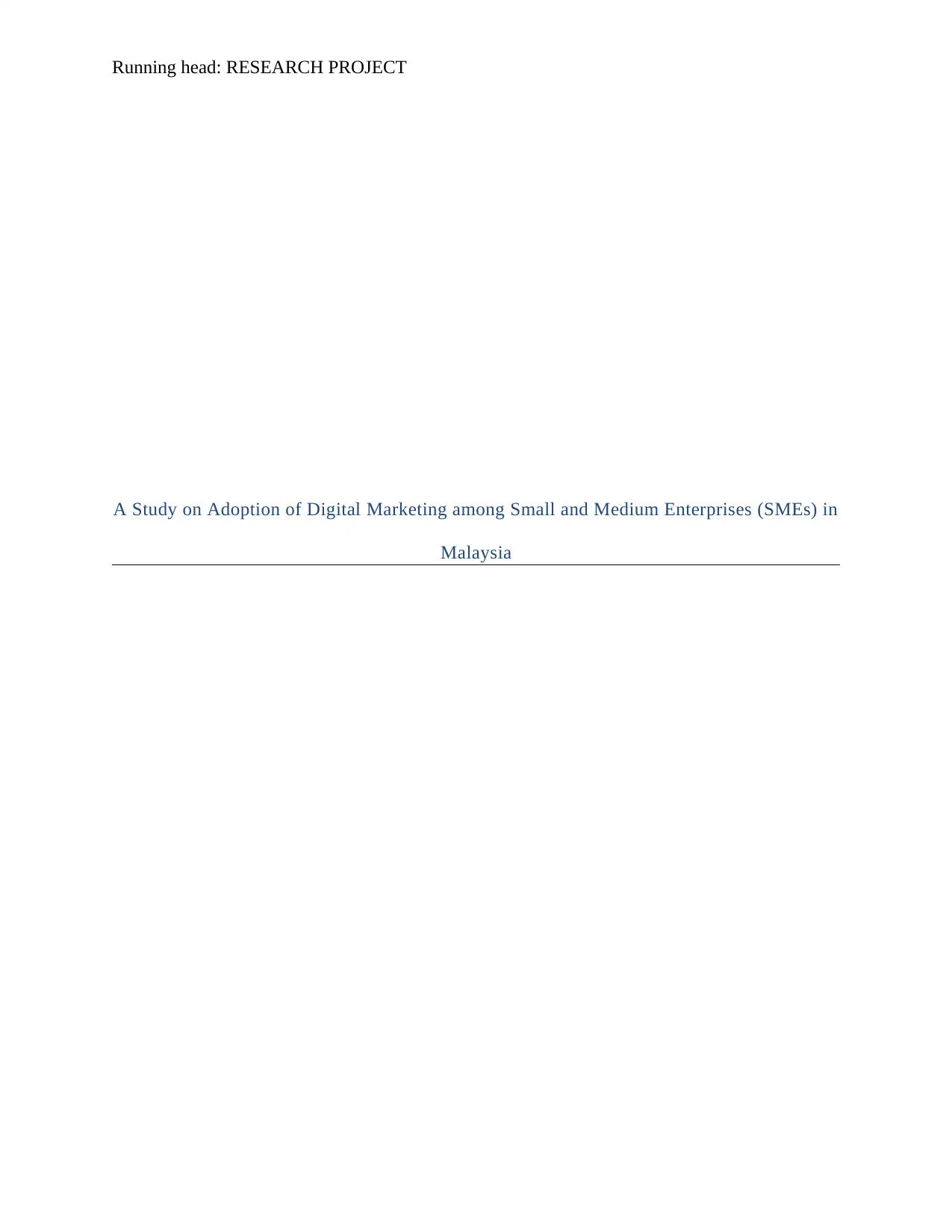
Running head: RESEARCH PROJECT
A Study on Adoption of Digital Marketing among Small and Medium Enterprises (SMEs) in
Malaysia
A Study on Adoption of Digital Marketing among Small and Medium Enterprises (SMEs) in
Malaysia
Paraphrase This Document
Need a fresh take? Get an instant paraphrase of this document with our AI Paraphraser
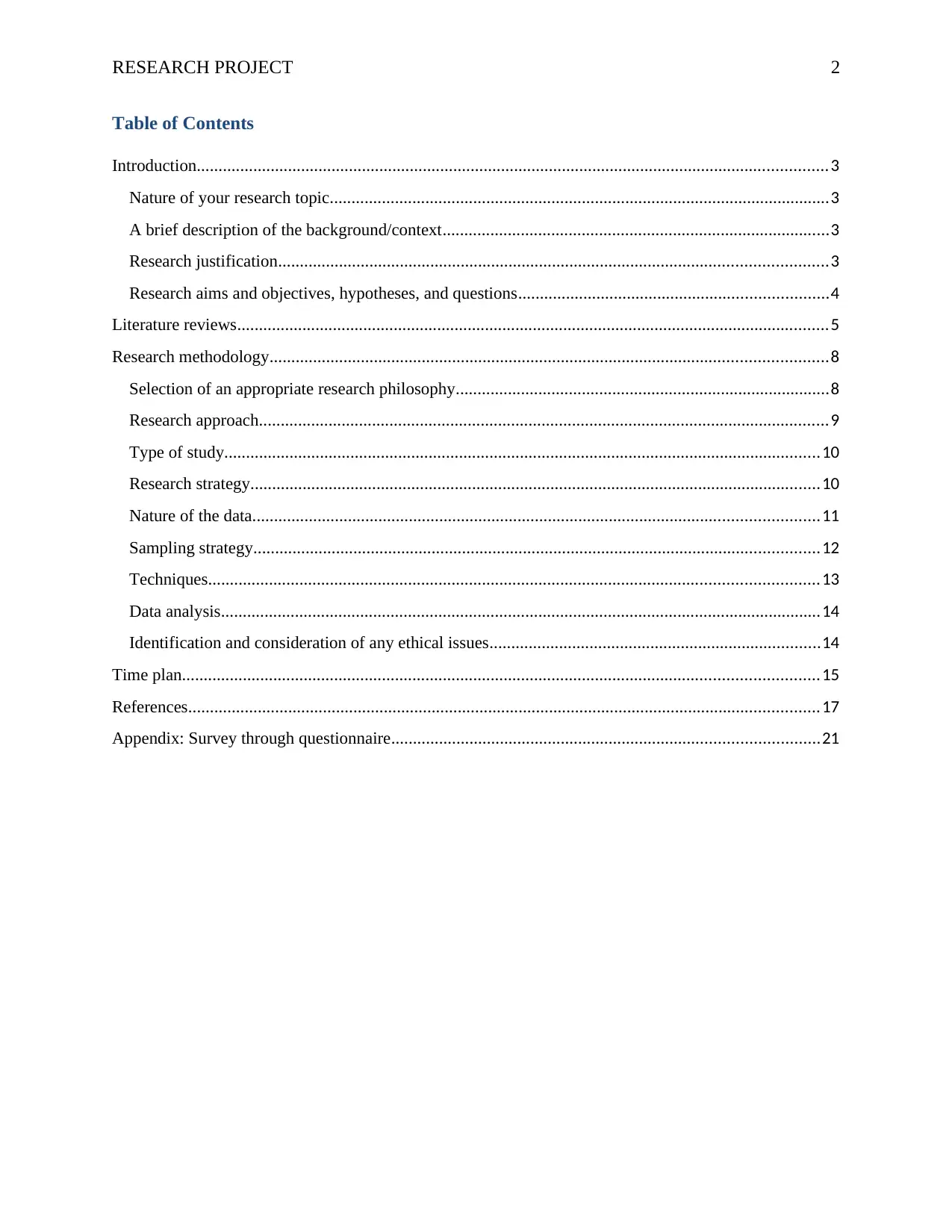
RESEARCH PROJECT 2
Table of Contents
Introduction.................................................................................................................................................3
Nature of your research topic...................................................................................................................3
A brief description of the background/context.........................................................................................3
Research justification..............................................................................................................................3
Research aims and objectives, hypotheses, and questions.......................................................................4
Literature reviews........................................................................................................................................5
Research methodology................................................................................................................................8
Selection of an appropriate research philosophy......................................................................................8
Research approach...................................................................................................................................9
Type of study.........................................................................................................................................10
Research strategy...................................................................................................................................10
Nature of the data..................................................................................................................................11
Sampling strategy..................................................................................................................................12
Techniques............................................................................................................................................13
Data analysis..........................................................................................................................................14
Identification and consideration of any ethical issues............................................................................14
Time plan..................................................................................................................................................15
References.................................................................................................................................................17
Appendix: Survey through questionnaire..................................................................................................21
Table of Contents
Introduction.................................................................................................................................................3
Nature of your research topic...................................................................................................................3
A brief description of the background/context.........................................................................................3
Research justification..............................................................................................................................3
Research aims and objectives, hypotheses, and questions.......................................................................4
Literature reviews........................................................................................................................................5
Research methodology................................................................................................................................8
Selection of an appropriate research philosophy......................................................................................8
Research approach...................................................................................................................................9
Type of study.........................................................................................................................................10
Research strategy...................................................................................................................................10
Nature of the data..................................................................................................................................11
Sampling strategy..................................................................................................................................12
Techniques............................................................................................................................................13
Data analysis..........................................................................................................................................14
Identification and consideration of any ethical issues............................................................................14
Time plan..................................................................................................................................................15
References.................................................................................................................................................17
Appendix: Survey through questionnaire..................................................................................................21
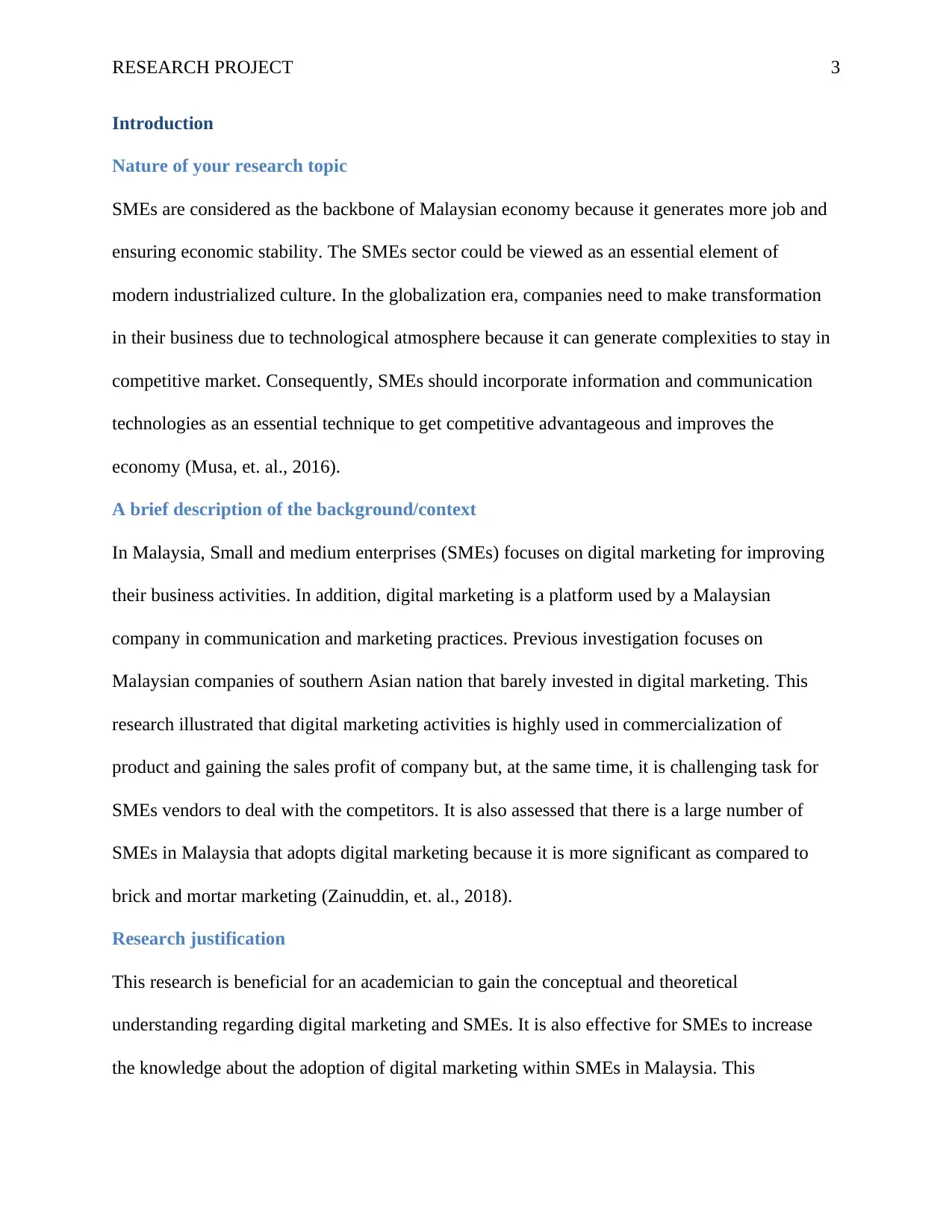
RESEARCH PROJECT 3
Introduction
Nature of your research topic
SMEs are considered as the backbone of Malaysian economy because it generates more job and
ensuring economic stability. The SMEs sector could be viewed as an essential element of
modern industrialized culture. In the globalization era, companies need to make transformation
in their business due to technological atmosphere because it can generate complexities to stay in
competitive market. Consequently, SMEs should incorporate information and communication
technologies as an essential technique to get competitive advantageous and improves the
economy (Musa, et. al., 2016).
A brief description of the background/context
In Malaysia, Small and medium enterprises (SMEs) focuses on digital marketing for improving
their business activities. In addition, digital marketing is a platform used by a Malaysian
company in communication and marketing practices. Previous investigation focuses on
Malaysian companies of southern Asian nation that barely invested in digital marketing. This
research illustrated that digital marketing activities is highly used in commercialization of
product and gaining the sales profit of company but, at the same time, it is challenging task for
SMEs vendors to deal with the competitors. It is also assessed that there is a large number of
SMEs in Malaysia that adopts digital marketing because it is more significant as compared to
brick and mortar marketing (Zainuddin, et. al., 2018).
Research justification
This research is beneficial for an academician to gain the conceptual and theoretical
understanding regarding digital marketing and SMEs. It is also effective for SMEs to increase
the knowledge about the adoption of digital marketing within SMEs in Malaysia. This
Introduction
Nature of your research topic
SMEs are considered as the backbone of Malaysian economy because it generates more job and
ensuring economic stability. The SMEs sector could be viewed as an essential element of
modern industrialized culture. In the globalization era, companies need to make transformation
in their business due to technological atmosphere because it can generate complexities to stay in
competitive market. Consequently, SMEs should incorporate information and communication
technologies as an essential technique to get competitive advantageous and improves the
economy (Musa, et. al., 2016).
A brief description of the background/context
In Malaysia, Small and medium enterprises (SMEs) focuses on digital marketing for improving
their business activities. In addition, digital marketing is a platform used by a Malaysian
company in communication and marketing practices. Previous investigation focuses on
Malaysian companies of southern Asian nation that barely invested in digital marketing. This
research illustrated that digital marketing activities is highly used in commercialization of
product and gaining the sales profit of company but, at the same time, it is challenging task for
SMEs vendors to deal with the competitors. It is also assessed that there is a large number of
SMEs in Malaysia that adopts digital marketing because it is more significant as compared to
brick and mortar marketing (Zainuddin, et. al., 2018).
Research justification
This research is beneficial for an academician to gain the conceptual and theoretical
understanding regarding digital marketing and SMEs. It is also effective for SMEs to increase
the knowledge about the adoption of digital marketing within SMEs in Malaysia. This
⊘ This is a preview!⊘
Do you want full access?
Subscribe today to unlock all pages.

Trusted by 1+ million students worldwide
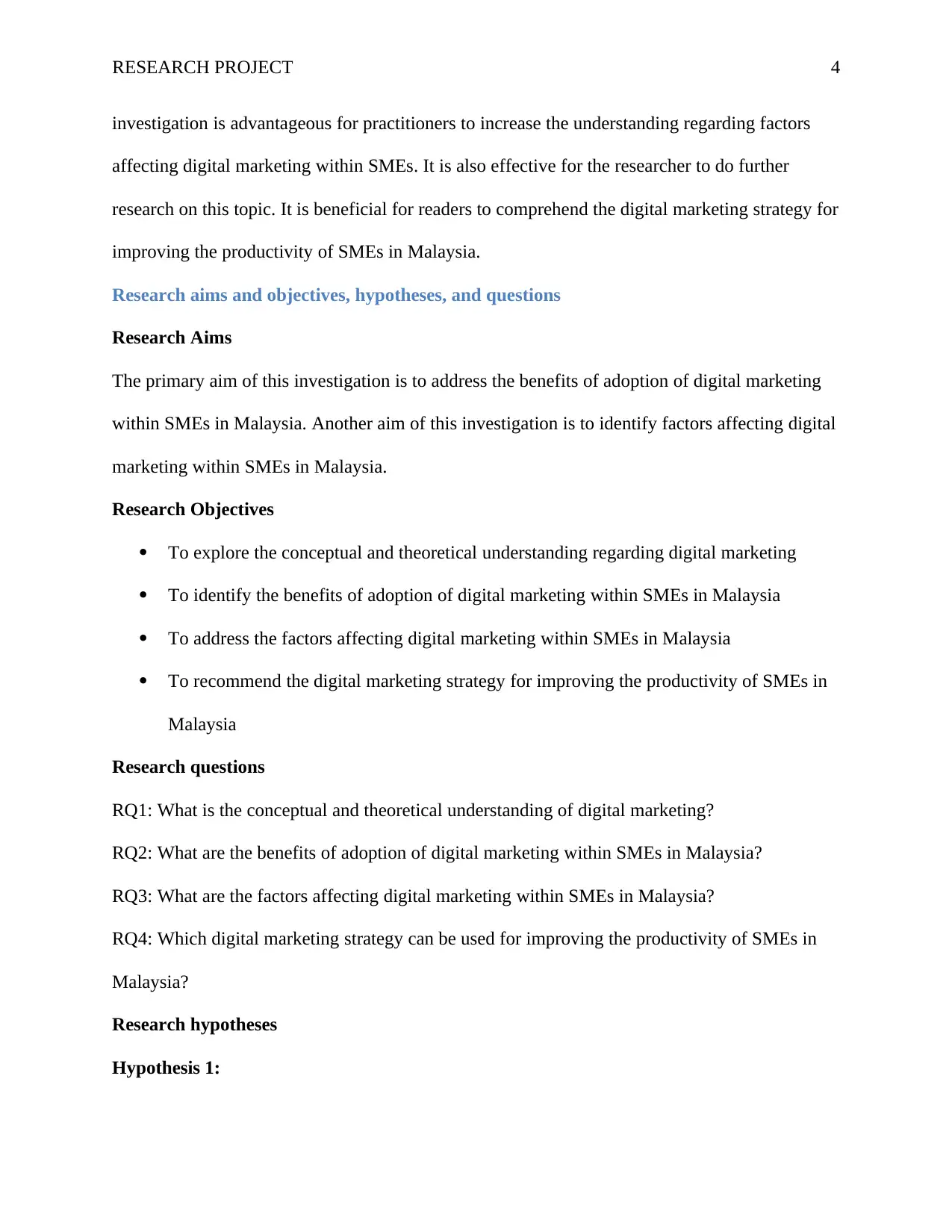
RESEARCH PROJECT 4
investigation is advantageous for practitioners to increase the understanding regarding factors
affecting digital marketing within SMEs. It is also effective for the researcher to do further
research on this topic. It is beneficial for readers to comprehend the digital marketing strategy for
improving the productivity of SMEs in Malaysia.
Research aims and objectives, hypotheses, and questions
Research Aims
The primary aim of this investigation is to address the benefits of adoption of digital marketing
within SMEs in Malaysia. Another aim of this investigation is to identify factors affecting digital
marketing within SMEs in Malaysia.
Research Objectives
To explore the conceptual and theoretical understanding regarding digital marketing
To identify the benefits of adoption of digital marketing within SMEs in Malaysia
To address the factors affecting digital marketing within SMEs in Malaysia
To recommend the digital marketing strategy for improving the productivity of SMEs in
Malaysia
Research questions
RQ1: What is the conceptual and theoretical understanding of digital marketing?
RQ2: What are the benefits of adoption of digital marketing within SMEs in Malaysia?
RQ3: What are the factors affecting digital marketing within SMEs in Malaysia?
RQ4: Which digital marketing strategy can be used for improving the productivity of SMEs in
Malaysia?
Research hypotheses
Hypothesis 1:
investigation is advantageous for practitioners to increase the understanding regarding factors
affecting digital marketing within SMEs. It is also effective for the researcher to do further
research on this topic. It is beneficial for readers to comprehend the digital marketing strategy for
improving the productivity of SMEs in Malaysia.
Research aims and objectives, hypotheses, and questions
Research Aims
The primary aim of this investigation is to address the benefits of adoption of digital marketing
within SMEs in Malaysia. Another aim of this investigation is to identify factors affecting digital
marketing within SMEs in Malaysia.
Research Objectives
To explore the conceptual and theoretical understanding regarding digital marketing
To identify the benefits of adoption of digital marketing within SMEs in Malaysia
To address the factors affecting digital marketing within SMEs in Malaysia
To recommend the digital marketing strategy for improving the productivity of SMEs in
Malaysia
Research questions
RQ1: What is the conceptual and theoretical understanding of digital marketing?
RQ2: What are the benefits of adoption of digital marketing within SMEs in Malaysia?
RQ3: What are the factors affecting digital marketing within SMEs in Malaysia?
RQ4: Which digital marketing strategy can be used for improving the productivity of SMEs in
Malaysia?
Research hypotheses
Hypothesis 1:
Paraphrase This Document
Need a fresh take? Get an instant paraphrase of this document with our AI Paraphraser
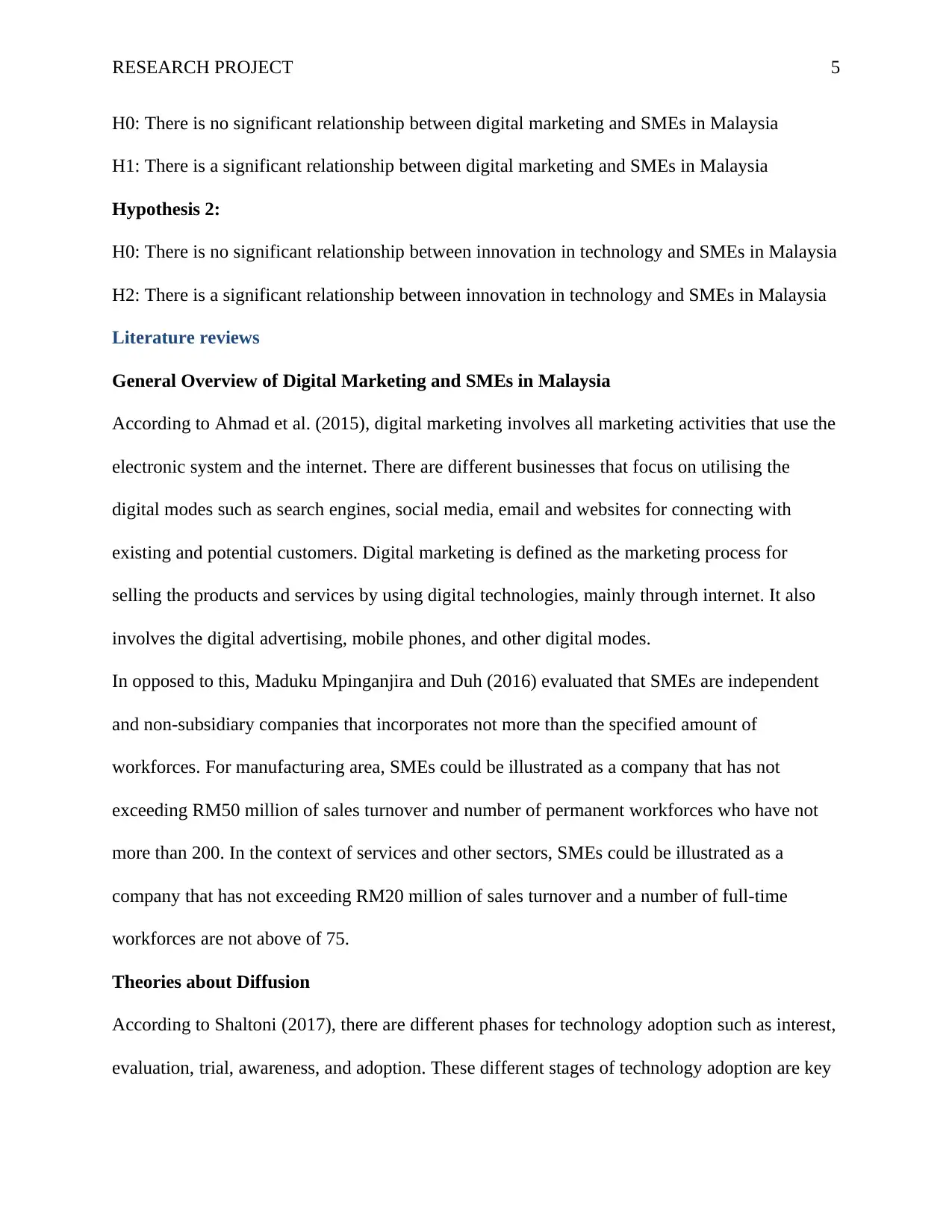
RESEARCH PROJECT 5
H0: There is no significant relationship between digital marketing and SMEs in Malaysia
H1: There is a significant relationship between digital marketing and SMEs in Malaysia
Hypothesis 2:
H0: There is no significant relationship between innovation in technology and SMEs in Malaysia
H2: There is a significant relationship between innovation in technology and SMEs in Malaysia
Literature reviews
General Overview of Digital Marketing and SMEs in Malaysia
According to Ahmad et al. (2015), digital marketing involves all marketing activities that use the
electronic system and the internet. There are different businesses that focus on utilising the
digital modes such as search engines, social media, email and websites for connecting with
existing and potential customers. Digital marketing is defined as the marketing process for
selling the products and services by using digital technologies, mainly through internet. It also
involves the digital advertising, mobile phones, and other digital modes.
In opposed to this, Maduku Mpinganjira and Duh (2016) evaluated that SMEs are independent
and non-subsidiary companies that incorporates not more than the specified amount of
workforces. For manufacturing area, SMEs could be illustrated as a company that has not
exceeding RM50 million of sales turnover and number of permanent workforces who have not
more than 200. In the context of services and other sectors, SMEs could be illustrated as a
company that has not exceeding RM20 million of sales turnover and a number of full-time
workforces are not above of 75.
Theories about Diffusion
According to Shaltoni (2017), there are different phases for technology adoption such as interest,
evaluation, trial, awareness, and adoption. These different stages of technology adoption are key
H0: There is no significant relationship between digital marketing and SMEs in Malaysia
H1: There is a significant relationship between digital marketing and SMEs in Malaysia
Hypothesis 2:
H0: There is no significant relationship between innovation in technology and SMEs in Malaysia
H2: There is a significant relationship between innovation in technology and SMEs in Malaysia
Literature reviews
General Overview of Digital Marketing and SMEs in Malaysia
According to Ahmad et al. (2015), digital marketing involves all marketing activities that use the
electronic system and the internet. There are different businesses that focus on utilising the
digital modes such as search engines, social media, email and websites for connecting with
existing and potential customers. Digital marketing is defined as the marketing process for
selling the products and services by using digital technologies, mainly through internet. It also
involves the digital advertising, mobile phones, and other digital modes.
In opposed to this, Maduku Mpinganjira and Duh (2016) evaluated that SMEs are independent
and non-subsidiary companies that incorporates not more than the specified amount of
workforces. For manufacturing area, SMEs could be illustrated as a company that has not
exceeding RM50 million of sales turnover and number of permanent workforces who have not
more than 200. In the context of services and other sectors, SMEs could be illustrated as a
company that has not exceeding RM20 million of sales turnover and a number of full-time
workforces are not above of 75.
Theories about Diffusion
According to Shaltoni (2017), there are different phases for technology adoption such as interest,
evaluation, trial, awareness, and adoption. These different stages of technology adoption are key

RESEARCH PROJECT 6
investigation to comprehend the adoption stage between nations. It incorporates phases that
permit the SMEs to categories the nation in the adoption of technology.
In opposed to this, Hassan Nadzim and Shiratuddin (2015) illustrated that the situation
motivation scale as a mean to measure the situational intrinsic with extrinsic motivation. It is
stated that the company is currently using digital marketing that served as a feasible scale to
determine motivation. There is also study regarding social media use between practitioners of
public relations for measuring motivation of participants to use Twitter for their jobs.
Digital Marketing Adoption within SMEs
In the view of Musa et al. (2015), there are considerable interest in digital marketing along with
notable research is conducted particularly on adoption procedure with theories of associated
technology adoption. There is a conceptual paper that considers research model such as
Technology Acceptance Model 3 and Hofstede’s cultural dimensions to address the cultural
impact on digital marketing and its effects on purchase behavior.
In contrast to this, Bin Ayob and Ibrahim (2016) stated that unified theory of acceptance along
with, implementation of technology demonstrates the positive relationship between this theory
and credibility. It also shows that there is higher probability to adopt digital marketing in SMEs.
There is also an actor-network theory that could be used by SMEs Malaysia for adopting the
digital marketing network because of its competency to illustrate the acceptance occurrence
within communication procedure of a company as compared to emphasize the individual factors
that can impact on adoption.
Digital marketing adoption factors
As per the view of Teixeira et al. (2017), the end user can major impact on procedure of
technology adoption between SMEs. It is addressed that the training processes in SMEs will
investigation to comprehend the adoption stage between nations. It incorporates phases that
permit the SMEs to categories the nation in the adoption of technology.
In opposed to this, Hassan Nadzim and Shiratuddin (2015) illustrated that the situation
motivation scale as a mean to measure the situational intrinsic with extrinsic motivation. It is
stated that the company is currently using digital marketing that served as a feasible scale to
determine motivation. There is also study regarding social media use between practitioners of
public relations for measuring motivation of participants to use Twitter for their jobs.
Digital Marketing Adoption within SMEs
In the view of Musa et al. (2015), there are considerable interest in digital marketing along with
notable research is conducted particularly on adoption procedure with theories of associated
technology adoption. There is a conceptual paper that considers research model such as
Technology Acceptance Model 3 and Hofstede’s cultural dimensions to address the cultural
impact on digital marketing and its effects on purchase behavior.
In contrast to this, Bin Ayob and Ibrahim (2016) stated that unified theory of acceptance along
with, implementation of technology demonstrates the positive relationship between this theory
and credibility. It also shows that there is higher probability to adopt digital marketing in SMEs.
There is also an actor-network theory that could be used by SMEs Malaysia for adopting the
digital marketing network because of its competency to illustrate the acceptance occurrence
within communication procedure of a company as compared to emphasize the individual factors
that can impact on adoption.
Digital marketing adoption factors
As per the view of Teixeira et al. (2017), the end user can major impact on procedure of
technology adoption between SMEs. It is addressed that the training processes in SMEs will
⊘ This is a preview!⊘
Do you want full access?
Subscribe today to unlock all pages.

Trusted by 1+ million students worldwide

RESEARCH PROJECT 7
permit transfer of understanding that is essential for making use of new technique and changing
the behaviour of workers with respect to technological change. Lack and inadequacy of technical
understanding, integration of benefits of e-commerce can create high complexity for SMEs.
In contrast to this, Mazzarol (2015) stated that there is no system that is effective in terms of e-
marketing. There are still certain challenges for SMEs while it comes to language and common
technology concerns such as spamming. Innovation in technology has created complexity in
technology compatibility with other business associated with the environment at the workplace.
As per the view of Olowolayemo et al. (2018), electronic-based marketing and adoption
procedure is highly impacted by higher authority in which, all decision from day to day activity
to future investments are developed by them in small and medium enterprises. In addition, a
small business that adopts IT is more likely to have a CEO who has different competencies with
respect to technology adoption such as knowledge, positive attitude, and innovation.
On the other hand, Kartiwi et al. (2018) stated that SMEs considers the technology as a technique
to beat the competition. While the rivalry initiates to consider technology to stay ahead then
SMEs can make advance changes by using new technology. Along with this, government impact,
policies, as well as initiatives can affect the technology adoption. The fundamental infrastructure
like a high-speed internet link is essential to motivate the technology adoption.
Digital marketing strategy for improving the performance of SMEs in Malaysia
According to Biucky and Harandi (2017), engine marketing should be used by SMEs in
Malaysia as it would aid to improve the productivity of the company. It enables the business to
battle with large corporations by being transparent in search engines. Since, an individual can use
search engines for addressing products at both local and online, hence corporation should use
effective words that are associated with selling the product of SMEs. In addition, top internet
permit transfer of understanding that is essential for making use of new technique and changing
the behaviour of workers with respect to technological change. Lack and inadequacy of technical
understanding, integration of benefits of e-commerce can create high complexity for SMEs.
In contrast to this, Mazzarol (2015) stated that there is no system that is effective in terms of e-
marketing. There are still certain challenges for SMEs while it comes to language and common
technology concerns such as spamming. Innovation in technology has created complexity in
technology compatibility with other business associated with the environment at the workplace.
As per the view of Olowolayemo et al. (2018), electronic-based marketing and adoption
procedure is highly impacted by higher authority in which, all decision from day to day activity
to future investments are developed by them in small and medium enterprises. In addition, a
small business that adopts IT is more likely to have a CEO who has different competencies with
respect to technology adoption such as knowledge, positive attitude, and innovation.
On the other hand, Kartiwi et al. (2018) stated that SMEs considers the technology as a technique
to beat the competition. While the rivalry initiates to consider technology to stay ahead then
SMEs can make advance changes by using new technology. Along with this, government impact,
policies, as well as initiatives can affect the technology adoption. The fundamental infrastructure
like a high-speed internet link is essential to motivate the technology adoption.
Digital marketing strategy for improving the performance of SMEs in Malaysia
According to Biucky and Harandi (2017), engine marketing should be used by SMEs in
Malaysia as it would aid to improve the productivity of the company. It enables the business to
battle with large corporations by being transparent in search engines. Since, an individual can use
search engines for addressing products at both local and online, hence corporation should use
effective words that are associated with selling the product of SMEs. In addition, top internet
Paraphrase This Document
Need a fresh take? Get an instant paraphrase of this document with our AI Paraphraser

RESEARCH PROJECT 8
marketing companies provide such services through search engine optimization. They can ensure
that the site is observable to an individual who is seeking a product when implementing the
search engine.
On the other hand, AlSharji Ahmad and Abu Bakar (2018) stated that location-based marketing
entails the website optimization for search results but also combines the search engine function
of maps. It is specifically true with Google in which, business could be considered into mapping
and identifying the data by enabling the prospective customers what they need to visit the
establishment. Customer services would be available for supporting the individual for deciding if
they are interested in product or services.
As per the view of Shaltoni et al. (2018), social media marketing could be tricky. Each individual
uses social media, but the adoption of social media into business could be difficult for small and
medium size company. In such a way, the company can face difficulty in terms of identifying the
kinds of media implemented and how it is applied. This is relied on type of business. For some
SMEs in Malaysia, being connect with the customers and providing them new offers can be
effective for increasing the sale.
Research methodology
Selection of an appropriate research philosophy
Research philosophy would aid the investigator to enhance their knowledge with respect to
current research concern. An appropriate type of research philosophy would support the
researcher to accumulate valid and reliable data related to research issue. Various types of
research philosophy would be practiced by the research scholar such as interpretivism research
philosophy, realism, and positivism research philosophy (Ahmad, Abu Bakar, and Ahmad,
2019).
marketing companies provide such services through search engine optimization. They can ensure
that the site is observable to an individual who is seeking a product when implementing the
search engine.
On the other hand, AlSharji Ahmad and Abu Bakar (2018) stated that location-based marketing
entails the website optimization for search results but also combines the search engine function
of maps. It is specifically true with Google in which, business could be considered into mapping
and identifying the data by enabling the prospective customers what they need to visit the
establishment. Customer services would be available for supporting the individual for deciding if
they are interested in product or services.
As per the view of Shaltoni et al. (2018), social media marketing could be tricky. Each individual
uses social media, but the adoption of social media into business could be difficult for small and
medium size company. In such a way, the company can face difficulty in terms of identifying the
kinds of media implemented and how it is applied. This is relied on type of business. For some
SMEs in Malaysia, being connect with the customers and providing them new offers can be
effective for increasing the sale.
Research methodology
Selection of an appropriate research philosophy
Research philosophy would aid the investigator to enhance their knowledge with respect to
current research concern. An appropriate type of research philosophy would support the
researcher to accumulate valid and reliable data related to research issue. Various types of
research philosophy would be practiced by the research scholar such as interpretivism research
philosophy, realism, and positivism research philosophy (Ahmad, Abu Bakar, and Ahmad,
2019).
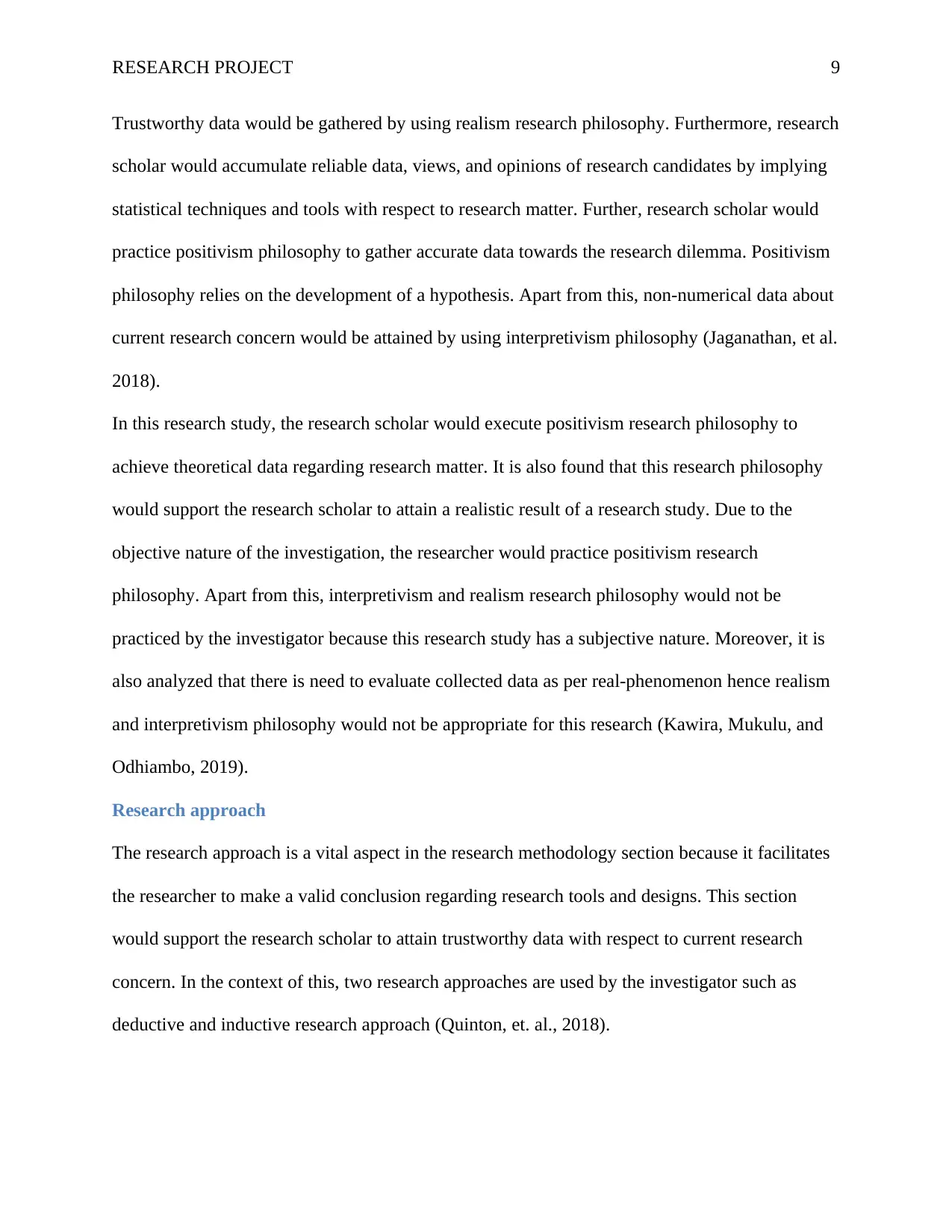
RESEARCH PROJECT 9
Trustworthy data would be gathered by using realism research philosophy. Furthermore, research
scholar would accumulate reliable data, views, and opinions of research candidates by implying
statistical techniques and tools with respect to research matter. Further, research scholar would
practice positivism philosophy to gather accurate data towards the research dilemma. Positivism
philosophy relies on the development of a hypothesis. Apart from this, non-numerical data about
current research concern would be attained by using interpretivism philosophy (Jaganathan, et al.
2018).
In this research study, the research scholar would execute positivism research philosophy to
achieve theoretical data regarding research matter. It is also found that this research philosophy
would support the research scholar to attain a realistic result of a research study. Due to the
objective nature of the investigation, the researcher would practice positivism research
philosophy. Apart from this, interpretivism and realism research philosophy would not be
practiced by the investigator because this research study has a subjective nature. Moreover, it is
also analyzed that there is need to evaluate collected data as per real-phenomenon hence realism
and interpretivism philosophy would not be appropriate for this research (Kawira, Mukulu, and
Odhiambo, 2019).
Research approach
The research approach is a vital aspect in the research methodology section because it facilitates
the researcher to make a valid conclusion regarding research tools and designs. This section
would support the research scholar to attain trustworthy data with respect to current research
concern. In the context of this, two research approaches are used by the investigator such as
deductive and inductive research approach (Quinton, et. al., 2018).
Trustworthy data would be gathered by using realism research philosophy. Furthermore, research
scholar would accumulate reliable data, views, and opinions of research candidates by implying
statistical techniques and tools with respect to research matter. Further, research scholar would
practice positivism philosophy to gather accurate data towards the research dilemma. Positivism
philosophy relies on the development of a hypothesis. Apart from this, non-numerical data about
current research concern would be attained by using interpretivism philosophy (Jaganathan, et al.
2018).
In this research study, the research scholar would execute positivism research philosophy to
achieve theoretical data regarding research matter. It is also found that this research philosophy
would support the research scholar to attain a realistic result of a research study. Due to the
objective nature of the investigation, the researcher would practice positivism research
philosophy. Apart from this, interpretivism and realism research philosophy would not be
practiced by the investigator because this research study has a subjective nature. Moreover, it is
also analyzed that there is need to evaluate collected data as per real-phenomenon hence realism
and interpretivism philosophy would not be appropriate for this research (Kawira, Mukulu, and
Odhiambo, 2019).
Research approach
The research approach is a vital aspect in the research methodology section because it facilitates
the researcher to make a valid conclusion regarding research tools and designs. This section
would support the research scholar to attain trustworthy data with respect to current research
concern. In the context of this, two research approaches are used by the investigator such as
deductive and inductive research approach (Quinton, et. al., 2018).
⊘ This is a preview!⊘
Do you want full access?
Subscribe today to unlock all pages.

Trusted by 1+ million students worldwide
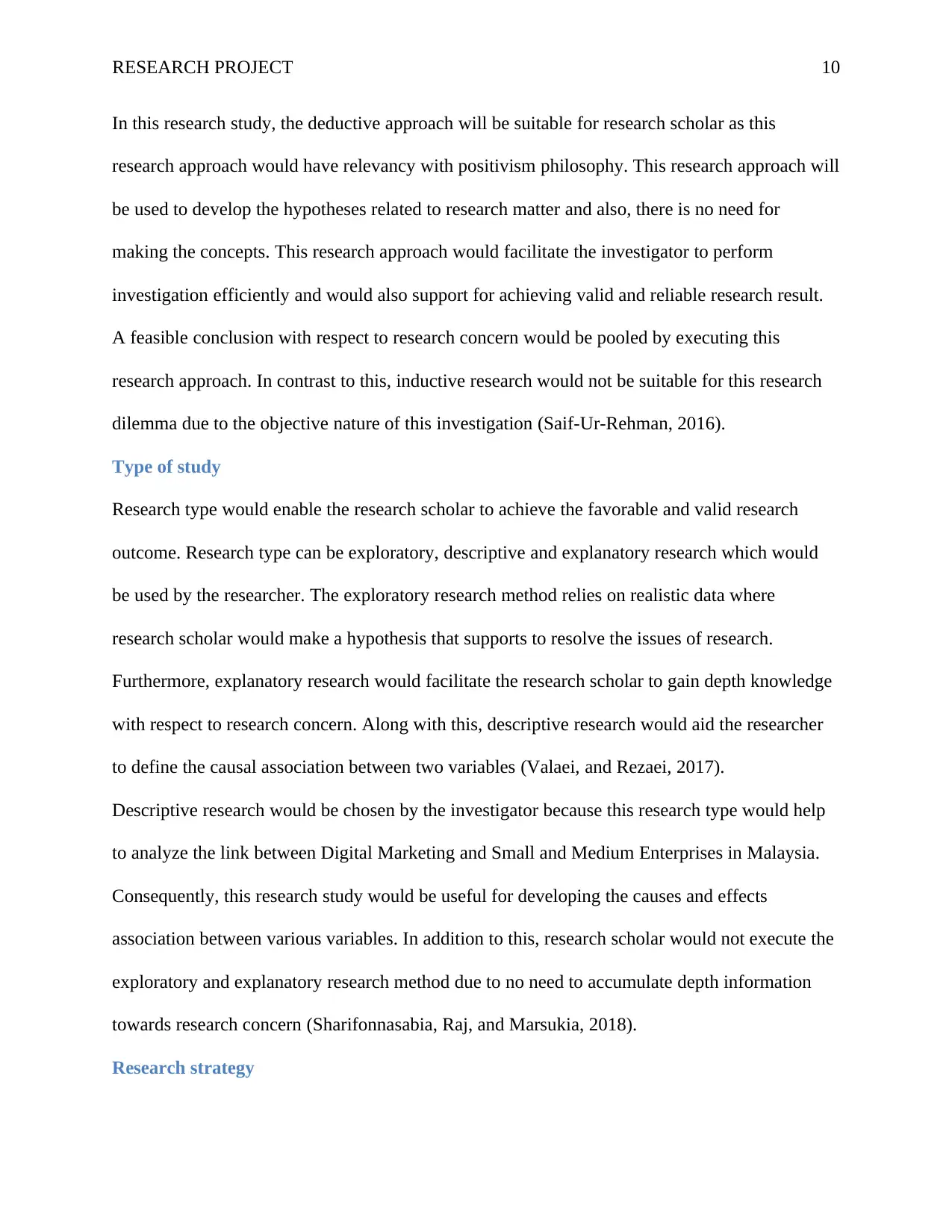
RESEARCH PROJECT 10
In this research study, the deductive approach will be suitable for research scholar as this
research approach would have relevancy with positivism philosophy. This research approach will
be used to develop the hypotheses related to research matter and also, there is no need for
making the concepts. This research approach would facilitate the investigator to perform
investigation efficiently and would also support for achieving valid and reliable research result.
A feasible conclusion with respect to research concern would be pooled by executing this
research approach. In contrast to this, inductive research would not be suitable for this research
dilemma due to the objective nature of this investigation (Saif-Ur-Rehman, 2016).
Type of study
Research type would enable the research scholar to achieve the favorable and valid research
outcome. Research type can be exploratory, descriptive and explanatory research which would
be used by the researcher. The exploratory research method relies on realistic data where
research scholar would make a hypothesis that supports to resolve the issues of research.
Furthermore, explanatory research would facilitate the research scholar to gain depth knowledge
with respect to research concern. Along with this, descriptive research would aid the researcher
to define the causal association between two variables (Valaei, and Rezaei, 2017).
Descriptive research would be chosen by the investigator because this research type would help
to analyze the link between Digital Marketing and Small and Medium Enterprises in Malaysia.
Consequently, this research study would be useful for developing the causes and effects
association between various variables. In addition to this, research scholar would not execute the
exploratory and explanatory research method due to no need to accumulate depth information
towards research concern (Sharifonnasabia, Raj, and Marsukia, 2018).
Research strategy
In this research study, the deductive approach will be suitable for research scholar as this
research approach would have relevancy with positivism philosophy. This research approach will
be used to develop the hypotheses related to research matter and also, there is no need for
making the concepts. This research approach would facilitate the investigator to perform
investigation efficiently and would also support for achieving valid and reliable research result.
A feasible conclusion with respect to research concern would be pooled by executing this
research approach. In contrast to this, inductive research would not be suitable for this research
dilemma due to the objective nature of this investigation (Saif-Ur-Rehman, 2016).
Type of study
Research type would enable the research scholar to achieve the favorable and valid research
outcome. Research type can be exploratory, descriptive and explanatory research which would
be used by the researcher. The exploratory research method relies on realistic data where
research scholar would make a hypothesis that supports to resolve the issues of research.
Furthermore, explanatory research would facilitate the research scholar to gain depth knowledge
with respect to research concern. Along with this, descriptive research would aid the researcher
to define the causal association between two variables (Valaei, and Rezaei, 2017).
Descriptive research would be chosen by the investigator because this research type would help
to analyze the link between Digital Marketing and Small and Medium Enterprises in Malaysia.
Consequently, this research study would be useful for developing the causes and effects
association between various variables. In addition to this, research scholar would not execute the
exploratory and explanatory research method due to no need to accumulate depth information
towards research concern (Sharifonnasabia, Raj, and Marsukia, 2018).
Research strategy
Paraphrase This Document
Need a fresh take? Get an instant paraphrase of this document with our AI Paraphraser

RESEARCH PROJECT 11
Research strategy would assist the research scholar to evaluate research concern by gathering
views and opinions of research participants towards research questions in an appropriate manner.
Research scholar would achieve reliable and valid conclusion by using relevant research
strategy. There are various methods entailed in research strategy such as literature review,
interview method, and survey through questionnaire observation, focused group and case study
(Molinillo and Japutra, 2017).
Survey through questionnaire method would be suitable research strategies for this investigation
as this strategy would support the investigator for addressing the adoption of digital marketing
among Small and Medium Enterprises (SMEs) in Malaysia. Relevant and trustworthy
information about research matter would be pooled by research scholar by utilizing interview
method (Oyebiyi, et. al., 2017). Selection of appropriate research strategy would aid the
investigator to obtain favorable research outcome. It would also allow the researcher to pool data
in the least time and cost. Both research strategies would enable the research scholar to enhance
the research quality. Research scholar can efficiently build an association with research
participants by using these research strategies. It would assist the researcher to get the aim and
objectives of investigation (Lim, Baharudin, and Low, 2016).
Nature of the data
Data collection method would facilitate the researcher to pool appropriate information related to
the research dilemma by using several sources such as primary and secondary sources. In
addition, it is also analyzed that selection of appropriate data gathering method would aid the
research scholar to get trustworthy information related to the research matter (Ramayah, et. al.,
2016).
Research strategy would assist the research scholar to evaluate research concern by gathering
views and opinions of research participants towards research questions in an appropriate manner.
Research scholar would achieve reliable and valid conclusion by using relevant research
strategy. There are various methods entailed in research strategy such as literature review,
interview method, and survey through questionnaire observation, focused group and case study
(Molinillo and Japutra, 2017).
Survey through questionnaire method would be suitable research strategies for this investigation
as this strategy would support the investigator for addressing the adoption of digital marketing
among Small and Medium Enterprises (SMEs) in Malaysia. Relevant and trustworthy
information about research matter would be pooled by research scholar by utilizing interview
method (Oyebiyi, et. al., 2017). Selection of appropriate research strategy would aid the
investigator to obtain favorable research outcome. It would also allow the researcher to pool data
in the least time and cost. Both research strategies would enable the research scholar to enhance
the research quality. Research scholar can efficiently build an association with research
participants by using these research strategies. It would assist the researcher to get the aim and
objectives of investigation (Lim, Baharudin, and Low, 2016).
Nature of the data
Data collection method would facilitate the researcher to pool appropriate information related to
the research dilemma by using several sources such as primary and secondary sources. In
addition, it is also analyzed that selection of appropriate data gathering method would aid the
research scholar to get trustworthy information related to the research matter (Ramayah, et. al.,
2016).
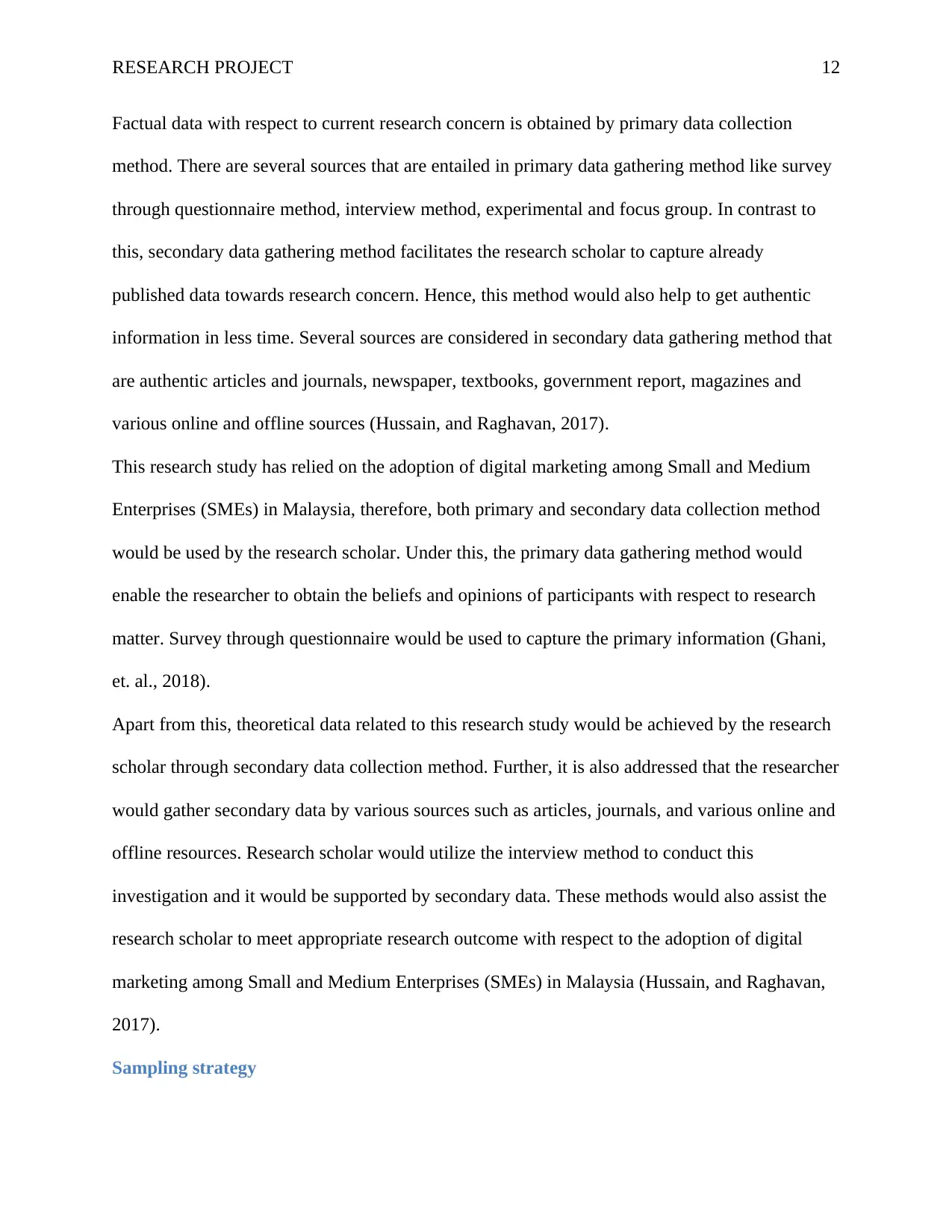
RESEARCH PROJECT 12
Factual data with respect to current research concern is obtained by primary data collection
method. There are several sources that are entailed in primary data gathering method like survey
through questionnaire method, interview method, experimental and focus group. In contrast to
this, secondary data gathering method facilitates the research scholar to capture already
published data towards research concern. Hence, this method would also help to get authentic
information in less time. Several sources are considered in secondary data gathering method that
are authentic articles and journals, newspaper, textbooks, government report, magazines and
various online and offline sources (Hussain, and Raghavan, 2017).
This research study has relied on the adoption of digital marketing among Small and Medium
Enterprises (SMEs) in Malaysia, therefore, both primary and secondary data collection method
would be used by the research scholar. Under this, the primary data gathering method would
enable the researcher to obtain the beliefs and opinions of participants with respect to research
matter. Survey through questionnaire would be used to capture the primary information (Ghani,
et. al., 2018).
Apart from this, theoretical data related to this research study would be achieved by the research
scholar through secondary data collection method. Further, it is also addressed that the researcher
would gather secondary data by various sources such as articles, journals, and various online and
offline resources. Research scholar would utilize the interview method to conduct this
investigation and it would be supported by secondary data. These methods would also assist the
research scholar to meet appropriate research outcome with respect to the adoption of digital
marketing among Small and Medium Enterprises (SMEs) in Malaysia (Hussain, and Raghavan,
2017).
Sampling strategy
Factual data with respect to current research concern is obtained by primary data collection
method. There are several sources that are entailed in primary data gathering method like survey
through questionnaire method, interview method, experimental and focus group. In contrast to
this, secondary data gathering method facilitates the research scholar to capture already
published data towards research concern. Hence, this method would also help to get authentic
information in less time. Several sources are considered in secondary data gathering method that
are authentic articles and journals, newspaper, textbooks, government report, magazines and
various online and offline sources (Hussain, and Raghavan, 2017).
This research study has relied on the adoption of digital marketing among Small and Medium
Enterprises (SMEs) in Malaysia, therefore, both primary and secondary data collection method
would be used by the research scholar. Under this, the primary data gathering method would
enable the researcher to obtain the beliefs and opinions of participants with respect to research
matter. Survey through questionnaire would be used to capture the primary information (Ghani,
et. al., 2018).
Apart from this, theoretical data related to this research study would be achieved by the research
scholar through secondary data collection method. Further, it is also addressed that the researcher
would gather secondary data by various sources such as articles, journals, and various online and
offline resources. Research scholar would utilize the interview method to conduct this
investigation and it would be supported by secondary data. These methods would also assist the
research scholar to meet appropriate research outcome with respect to the adoption of digital
marketing among Small and Medium Enterprises (SMEs) in Malaysia (Hussain, and Raghavan,
2017).
Sampling strategy
⊘ This is a preview!⊘
Do you want full access?
Subscribe today to unlock all pages.

Trusted by 1+ million students worldwide
1 out of 23
Related Documents
Your All-in-One AI-Powered Toolkit for Academic Success.
+13062052269
info@desklib.com
Available 24*7 on WhatsApp / Email
![[object Object]](/_next/static/media/star-bottom.7253800d.svg)
Unlock your academic potential
Copyright © 2020–2025 A2Z Services. All Rights Reserved. Developed and managed by ZUCOL.




